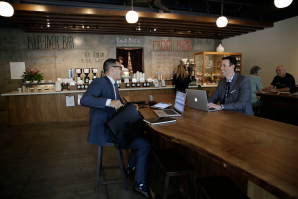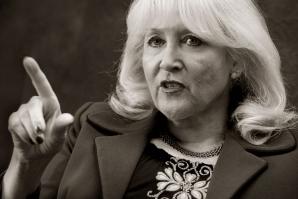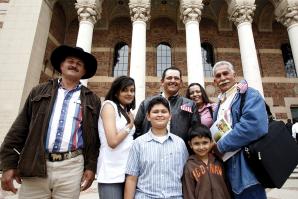Last July, an 11-year-old Guatemalan girl named Luisa and her mother sat in front of Los Angeles immigration judge Frank Travieso. The girl had been detained after crossing into the United States illegally the previous year at her mother’s urging. Her mother told the judge she’d feared for her daughter’s safety in her home country but didn’t specify why. Now, Luisa sat in the courtroom with 25 other children, many with their feet dangling from their chairs.
According to an account of the hearing by the American Civil Liberties Union of Southern California, Travieso encouraged them to find pro bono lawyers to help them — otherwise, they’d face an uphill battle. Unaccompanied kids like Luisa almost always lose in immigration court. Now, a state law passed in September could change the game, giving local attorneys the means to represent more of the growing wave of Central American children crossing into the United States.
Life and Death Decisions
Since 2011, ever-rising numbers of Salvadoran, Guatemalan and Honduran children have been streaming across the U.S.-Mexico border. In fiscal year 2011, they numbered about 16,000. By fiscal 2013, that number had more than doubled to 39,000. Last year, it hit almost 69,000. They’re leaving those three countries for a reason. The homicide rates of Honduras, El Salvador and Guatemala rank first, fourth, and fifth in the world.
Little more than half of the nearly 13,000 children who have faced deportation proceedings in California since 2005 have had attorneys.
Once on U.S. soil, they’re guaranteed some measure of due process in petitioning to stay. After a 2008 federal law meant to combat sex trafficking was passed unanimously by both houses of Congress, unaccompanied children from countries that don’t share borders with the United States can’t be deported without an immigration court hearing. That’s designed to keep them from being put back into dangerous situations. Most of the children who have come from El Salvador, Guatemala and Honduras also qualify for international protection under a 1951 international convention on refugees, according to the United Nations. A UN study of a representative sample of children from those three countries being held in U.S. detention concluded that more than half are fleeing either gang or drug violence or abuse in their homes.
But they can claim that protection only in immigration court. And to have a chance in court, they need a lawyer. A compilation of government data last summer through a project at Syracuse University found that a little more than half of the nearly 13,000 children who have faced deportation proceedings in California since 2005 have had attorneys. Immigration judges ordered them deported 41 percent of the time. For those who didn’t have lawyers, the figure was 89 percent.
Those decisions can mean life or death. In August, the head of the morgue in the Honduran city San Pedro Sula told the Los Angeles Times that at least one deported child has turned up dead of gunshot wounds — the city has the world’s highest murder rate. “This is why these children need representation — so something like that doesn’t happen again,” says Amagda Pérez, executive director at the Sacramento-based California Rural Legal Assistance Foundation, a nonprofit that provides lawyers for the state’s rural poor.
CRLAF and the UC Davis Immigration Law Clinic have taken on a limited number of these children’s cases pro bono. Two of their clients, a Honduran and a Salvadoran, at first offered but later declined to share their stories because they fear retaliation by gangs against their families in their home countries and rejection of their asylum applications should their cases become public. One was the missed target of a gang shooting. The other was regularly assaulted by gang members and saw a family member and two classmates murdered.
“We’re all pretty good about taking as many pro bono cases as we can, but there’s a limit.” Juliet Turner-Lloveras, immigration attorney, Considine Sorensen & Trujillo
Few Free Legal Resources for Children
Children like these have ended up in Sacramento, and more are likely on their way. When border patrol agents detain unaccompanied children, they release them to the custody of the U.S. Department of Health and Human Services for food, shelter and medical care. They’re then turned over to a U.S. sponsor, usually a family member, while their cases are pending in immigration court. Federal statistics show that 56 of these children have been released to sponsors in Sacramento County this year, making it one of 16 California counties with more than 50 such kids. And that number is a “moving target,” says Pérez. As more cross the border and are placed with sponsors, it’s sure to rise.
Their cases pose special problems. An unaccompanied child’s best chance at a green card is to apply for “special immigrant juvenile” status. Getting it is a two-step process. They must first prove in a juvenile court that gang or family violence in their home country makes it dangerous to return and be reunited with their families. Only then can they go in front of an immigration judge, who reviews all of the evidence to determine whether their petition has merit. That means they need a lawyer who knows the workings of both the juvenile and immigration court systems.
But at the beginning, many of these children are scared to tell their stories — even to their lawyers. “For some, it takes two or three interviews to gain their trust,” says local immigration attorney Douglas Lehrman. Because they don’t normally have access to a fair legal process in their home countries, they’re often afraid of authority, he says.
Those best qualified to represent them are full-time immigration lawyers, but they can take only so many cases pro bono. Immigration law firms are small, especially in Sacramento, says Erika Gonzalez of Opening Doors, an area nonprofit that offers immigrants sliding-scale legal assistance. “I think we’re all pretty good about taking as many pro bono cases as we can, but there’s a limit,” says Juliet Turner-Lloveras, an immigration attorney who has represented unaccompanied children at Considine Sorensen & Trujillo in Sacramento.
The flow of unaccompanied children won’t stop soon. The federal Department of Homeland Security is projecting that in 2015, their number will double to 145,000.
New Law, New Money for Lawyers
That’s why last summer, state officials were already recruiting lawyers in other fields to take these cases for free after getting some training. In July, state Attorney General Kamala Harris met with prestigious law firms and corporate lawyers in Los Angeles to urge them to donate hundreds of hours of pro bono work to represent children this year. Legal aid nonprofits like the San Francisco-based Legal Services for Children followed up by offering training and ongoing mentorship to corporate attorneys and others on how to represent these kids in court, says Abigail Trillin, the organization’s executive director.
Efforts like these have just gotten started in the Central Valley. In early November, the UC Davis School of Law, California Rural Legal Assistance Foundation and a sister organization held a training for about 30 Central Valley lawyers on the finer points of representing unaccompanied minors. Long term, they and other groups are trying to create a permanent network of nonprofits and pro bono lawyers that can assist one another and connect children with representation and services.
In September, California became the first state to kick in public money — $3 million — for more legal representation for unaccompanied kids. The funds go through the state Department of Social Services, which in turn contracts with a statewide pool of nonprofit legal service organizations that have experience in unaccompanied children’s cases. In turn, those nonprofits can hire more staff attorneys or subcontract with private immigration lawyers to ramp up capacity. Nonprofits began submitting applications in November to be included in the statewide pool.
Federal and local officials are setting aside money too. In mid-September, San Francisco city and county allocated $2.1 million, and in early October, the Obama administration announced that it would provide $9 million nationwide. Those funds will go some way toward meeting the need. A report by the San Francisco Board of Supervisors estimated that giving each unaccompanied child in that city a lawyer would cost about $3,000 each. At that rate, representing all of the unaccompanied children in California would require about $7 million.
Representing all of the unaccompanied children in California would require about $7 million.
The new law completes an about-face in state policy 20 years after Proposition 187 barred those in the country illegally from public services like health care and education. “It’s a major political change by the state of California to recognize that this really is a human rights situation,” Lehrman says.
Not everyone agrees. Senate Bill 873, which allocated the new money, attracted few Republican votes during passage, and a Los Angeles Times/USC poll in September found voters split on whether unaccompanied children should be allowed to stay months or years while they await a hearing.
Some believe that offering children help attracts more of them to the United States. “We understand that kids are special cases … but there’s a larger problem of providing services [like legal representation] that encourage further illegal immigration,” argues Ric Oberlink, a Berkeley-based spokesperson for advocacy group Californians for Population Stabilization. If those services do help convince children to make the dangerous journey here, he says, “we may actually be causing them more damage.”
It’s not yet clear whether governmental policy is driving the flight north. That’s because Central American countries like Costa Rica, Nicaragua and Mexico have seen their own surges of refugees from Honduras, El Salvador and Guatemala — they’ve reported a 712-percent increase in asylum applications from those countries since 2008.
What does seem certain is that the flow of unaccompanied children won’t stop soon. The federal Department of Homeland Security is projecting that in 2015, their number will double to 145,000. “We kind of need all hands on deck on this for this situation,” Trillin says.
Recommended For You

Juris Prudence
Changes to the legal market are motivating attorneys to bootstrap
Alex Medina and Brandon McKelvey’s new law firm looks more like a bootstrapped tech startup than a high-end legal practice. It’s one model among the boutique firms whose numbers have taken off in the region this year. The improving economy, a buyer’s market for legal services, and the lures of startup culture have upended Sacramento’s legal landscape.

Is Sacramento Permanently Democratic?
Voter trends with lasting effects
The 2012 election may have spelled the end for a 30-year boomlet of Republican legislative and congressional representation in Sacramento.

Minority Status
Resolute leadership for a floundering GOP
Assemblywoman Connie Conway, a Tulare County Republican, made her presence felt immediately in the California Legislature.

Immigration Reform
Arizona laws spark local dialogue
When Barack Obama was running for president in 2008, he vowed that if elected he would take up George Bush’s failed 2007 effort to reform the nation’s immigration policy, secure U.S. borders and provide a path to citizenship for undocumented persons who had lived in America for years. Since then, however, issues such as health care reform have pushed immigration to the back burner.



